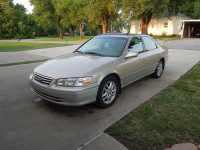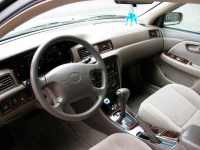The Camry, now in its fifth generation, is sold in a hundred countries. It is one of the few global products even for the multinational Toyota. On the American market in particular, it is developing stiff sales competition with such models as the Honda Accord and Ford Taurus, remaining the best-selling product on the passenger car market continuously for four years. It is over 4.8 meters long and just under 1.8 meters wide. The main parts of the platform are unified with the Windom model, and thanks to such a great device, it is perceived as a base car in the larger America, just like the Corolla in Japan.
 Early generations of this car were developed specifically for Japan, and those cars that were called Camry in the U.S. were produced in Japan under other names (Scepter and Camry Gracia). Now, the main responsibility of the Camry is to set the sales record in the U.S. This time, the new Camry being launched in the Japanese market should become the American bestseller.
Early generations of this car were developed specifically for Japan, and those cars that were called Camry in the U.S. were produced in Japan under other names (Scepter and Camry Gracia). Now, the main responsibility of the Camry is to set the sales record in the U.S. This time, the new Camry being launched in the Japanese market should become the American bestseller.
It has the same frame as the previously marketed Windom, with the same state-of-the-art 2.4L four-cylinder engine as the Estima, Ipsum, Harrier, Kluger V, etc. models. In Japan, it is sold alongside the Corolla, occupying an intermediate position between it and the upscale Windom model.
The new Camry uses a package technology that Toyota has introduced in the last few years. It consists of a significant increase in wheelbase and height. However, these are large dimensions, close to the limit in Japan, so there is no impression of fitting millimeters, as in the Corolla and Vitz models. Still, it's a big front-wheel-drive car with a front-engine layout, and that's why there's plenty of headroom. The front and rear seats can fit tall men up to 2 meters tall freely, and you can't help but think, "How nice that this is such a huge car!"
The 2.4L four-cylinder engine this time uses new electronically controlled throttles for smooth and powerful performance, as well as Japan's highest 4-star emission cleanliness. This 2AZ-FE engine initially had a strong reputation for smooth, powerful low-end performance, as befits the latest systems. Its performance makes it easy to pull the large minivans and sports cars described above, and it's only natural that it makes the Camry go fast. It has ample dynamic performance when needed.
 The suspension, on the other hand, uses the "TEMS" variable stiffness suspension (standard on the Touring modification), which allows the damping force to be switched in 16 steps in each mode at any time. As I reported in an urgent test drive report on the new Windom, the latest "TEMS" suspension demonstrates its excellence on the equipped road, but on the current run-in track, which has a wavy surface, it sometimes felt like the wheels wouldn't listen to the steering wheel when the switch was put in any mode. For both the Windom, which is positioned as a high-end high-tech car, and the Camry, which is the base model with "roomy cabin appeal due to its large body", we recommend standard modifications that do not require additional costs and show a balanced driving performance in all conditions.
The suspension, on the other hand, uses the "TEMS" variable stiffness suspension (standard on the Touring modification), which allows the damping force to be switched in 16 steps in each mode at any time. As I reported in an urgent test drive report on the new Windom, the latest "TEMS" suspension demonstrates its excellence on the equipped road, but on the current run-in track, which has a wavy surface, it sometimes felt like the wheels wouldn't listen to the steering wheel when the switch was put in any mode. For both the Windom, which is positioned as a high-end high-tech car, and the Camry, which is the base model with "roomy cabin appeal due to its large body", we recommend standard modifications that do not require additional costs and show a balanced driving performance in all conditions.
Frankly speaking, I think the Camry is a sedan that is very difficult to sell in Japan. It seems to be close to the Crown model in terms of body size and engine displacement, but the concept called "sedan for practical use" is consistently focused on the overseas market, so it is clearly not adapted to the Japanese hierarchy. Honda Accord car, which has become a major competitor in the U.S. market, is sold in Japan with a special body number 5, so only the Nissan Cefiro (overseas - Maxima) can openly oppose it, apparently.
However, again it is thought that even in the XXI century there is a peculiar appeal in a big body. Free space implies a sense of openness in the cabin and a huge trunk, which is absolutely impossible to enjoy in a compact car. This is very convenient for users, because also in Japan there are often situations when it is necessary to put four adults in the car. In addition, when driving at high speeds for a long time, the large body has less wear and tear. In that sense, you can call a large body a gem for two and a half million yen (~$21,000). If you're specifically choosing a minivan or sports car "because it's wide," you should well enter the Camry, which sits high on the running boards.


-rear-and-front-view-camera-6.png)

